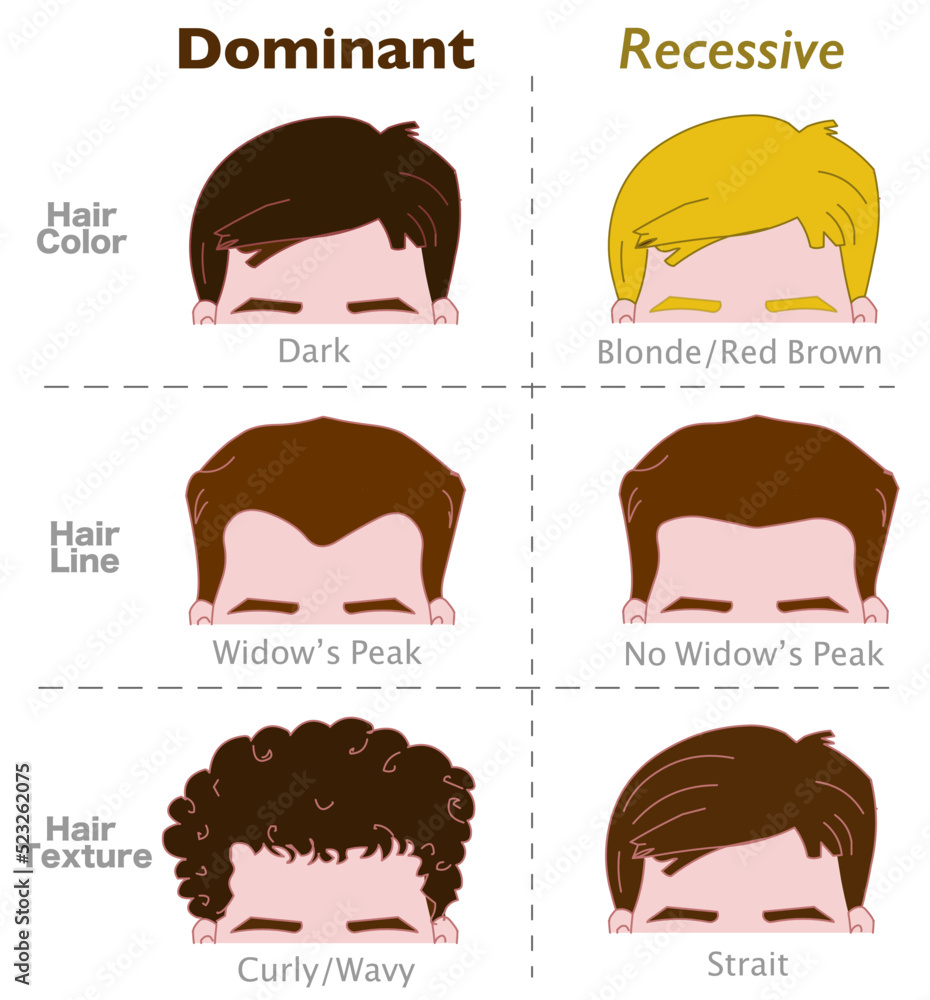First, what are traits?
Okay, imagine you’re designing a new character in a game or drawing someone. You get to pick their eye color, height, hair type, and more — these are traits. Traits are the characteristics or features we can observe in any living thing, like plants, animals, or humans.
Some examples of traits are:
- Eye color
- Hair texture
- Plant flower color
- Ear shape in animals
- Blood type in humans
Traits are controlled by genes — tiny instruction manuals inside our cells. Each trait is influenced by two copies of a gene: one from your mom and one from your dad.
🌟 Dominant vs Recessive – What's the difference?
Now here’s where things get interesting!
Genes come in different versions called alleles. One version might be stronger and take over, and the other one might be weaker and only show up if it’s alone.
Let’s break it down:
| Term | What it Means | Easy Example |
|---|---|---|
| Dominant allele | The stronger gene. It shows its effect even if there’s only one copy. | Brown eyes (B) – if you get one “B” from either parent, your eyes will be brown. |
| Recessive allele | The “quieter” gene. It only shows up if both copies are the same (recessive). | Blue eyes (b) – you need bb to have blue eyes. If you get Bb, you’ll still have brown eyes. |
So when a dominant allele (like B) is present, it overrules the recessive one.
🔬 Let’s Practice with an Example!
Imagine:
- Mom gives you B (brown eye gene)
- Dad gives you b (blue eye gene)
So your combination is Bb.
What color eyes will you have?
➡️ Brown, because B is dominant over b.
You still carry the blue eye gene (b), but you don’t show it unless you get another b from both parents (bb).
🌻 In Plants – What are some common dominant and recessive traits?
Here’s what Gregor Mendel (the father of genetics) noticed when he studied pea plants:
| Trait | Dominant | Recessive |
|---|---|---|
| Plant height | Tall | Short |
| Seed shape | Round | Wrinkled |
| Seed color | Yellow | Green |
| Flower color | Purple | White |
| Pod shape | Inflated | Constricted |
| Pod color | Green | Yellow |
| Flower position | Axial (along stem) | Terminal (at end) |
So for example, if a pea plant has the genes Tt (Tall from one parent, short from the other), the plant will still be tall — because tall is dominant.
🐶 In Animals – Examples of Traits
Let’s look at some animal traits:
| Trait | Dominant | Recessive |
|---|---|---|
| Fur color in mice | Black | White |
| Tail type in cats | Curly | Straight |
| Feather color in chickens | Black | White |
| Coat texture in dogs | Wire hair | Smooth hair |
So if a cat has genes Cc (curly from one parent, straight from the other), the tail will be curly — because curly is dominant!
🧍 In Humans – More Familiar Examples
Let’s bring it home with human traits!
| Trait | Dominant | Recessive |
|---|---|---|
| Eye color | Brown | Blue |
| Hair type | Curly | Straight |
| Earlobes | Free-hanging | Attached |
| Tongue rolling | Can roll | Can’t roll |
| Dimples | Present | Absent |
| Freckles | Present | Absent |
| Widow’s peak | Present | Absent |
So if you have the gene for dimples from one parent and the no-dimples gene from another, you’ll likely have dimples, because they’re dominant.
🤔 Quick Trick to Remember
Dominant = “Bossy”
Only one copy needed to show up.
(Think of it like turning on a light with just one switch.)
Recessive = “Shy”
Needs both copies to show.
(Like needing two keys to open a secret box.)
🎓 Final Thoughts: Why is this important?
Understanding dominant and recessive traits helps us:
- Predict how traits are inherited
- Understand family genetics
- See why siblings look different
- Learn about diseases passed through genes
It’s like solving a mystery with clues passed down from parents!
References
Altenburg, E. (1965). The relation of genes to traits. In Genetics (Revised ed., p. 16). Holt, Rinehart and Winston, Inc.
BiologyWise. (2022). Dominant and recessive traits in humans. Retrieved September 13, 2022, from https://biologywise.com/dominant-recessive-traits-in-humans
Classroom Partners. (2022). Punnett square. Retrieved September 13, 2022, from https://pressbooks.umn.edu/classroompartners/chapter/punnett-squares/
National Human Genome Research Institute (NIH). (2022). Recessive traits and alleles. Retrieved September 13, 2022, from https://www.genome.gov/genetics-glossary/Recessive-Traits-Alleles
Verma, P. S., & Agarwal, V. K. (2005). Mendel and his work. In Cell biology, genetics, molecular biology, evolution and ecology (Multicolor ed., pp. 29–30). S. Chand & Company Ltd.
.png)

.png)



.png)
.png)

No comments:
Post a Comment